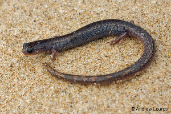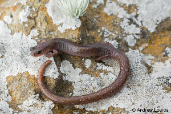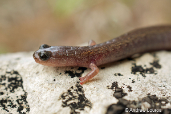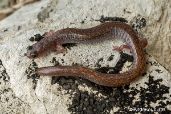Arguello Slender Salamander (Batrachoseps wakei)
Description: The largest male measured 2.6 inches snout to vent length. The largest female measured 2.7 inches snout to vent length. A large, moderately robust species of Slender Salamander with a rounded head that is not distinct from the neck and eyes that extend beyond the outline of the head when viewed from above.
Slender Salamanders have four toes on the front and hind feet. Dorsal color is light brown overlaid with tan to dull golden iridophores distributed as longitudinal streaks that appear to form irregular pale dorsolateral bands. Ventral surfaces are light tan. A faint orange cast on the tail that may become enlarged and cover the entire dorsum of the distal third of the tail in large adults. Small juvenile B. wakei are uniformly dark brown dorsally and tan ventrally, without tan dorsal vermiculations or orange iridophore patches, but with dense, punctate white guanophores on all lateral surfaces.
Habitat: As far as is known, this species only inhabits a narrow marine terrace containing relatively thick low vegetation in a dark sandy loam soil, in an area of enhanced offshore winds, fog drip, and rainfall. The loam soil holds burrows unlike the sandier soil on terraces nearby. The coastal area to the north of B. wakei habitat is mostly dune fields and the area to the south experiences much less fog drip and drainfall, which may limit the usable habitat for the species to the small area in which it has so far been found.
Range: Endemic to California. Found only in a very small area on the coast of Santa Barbara County on a narrow marine terrace centered on Point Arguello about 1,312 ft. wide by 2.5 miles long. Access to the entire area where the species has been found is restricted and completely off-limits to the public. Very likely a relict species with a very small range.
Found in these States:
CA
Diet: Not described. Other species of Slender Salamanders eat a variety of small invertebrates which they catch by sit-and-wait predation using a projectile tongue to catch prey.
Reproduction: Not described. Reproduction of other Slender Salamanders is terrestrial, with females laying eggs in moist places underground.
Status: The species has a very small range and lacks genetic diversity, which makes it vulnerable, but its habitat is inherently well-protected due to its restricted public access and ownership by ...the United States Space Force, the U.S. Coast Guard, and the Union Pacific Railroad Corporation and the governmental entities are expected to be supportive of management practices that aid in conservation of this species. This species was listed as Critically Imperiled by the 7/03/23 State of California Special Animals List.
Taxonomy: First discovered in May, 2006 on what is now Vandenberg Space Force Base in Santa Barbara County. Batrachoseps wakei was formally described by Sweet & Jockush in 2021 after years of study and analysis determined that the geography, morphology, and molecular make-up of this salamander support its recognition as a new species.
»» Kingdom: Animalia - Animals
»» Phylum: Chordata - Chordates
»» Subphylum: Vertebrata - Vertebrates
»» Class: Amphibia - (Amphibians)
»» Order: Caudata - Salamanders
»» Family: Plethodontidae - Lungless Salamanders
»» Genus: Batrachoseps
»» Species: Batrachoseps wakei - Arguello Slender Salamander
This article uses material from the Wikipedia article "ANIMAL", which is released under the Creative Commons Attribution-Share-Alike License 3.0. Content may have been omitted from the original, but no content has been changed or extended.
|






